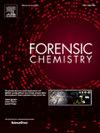Two AIE-actives difluoroboron compounds containing 3,4,5-trifluorophenyl group for latent fingerprints detection
IF 2.6
3区 医学
Q2 CHEMISTRY, ANALYTICAL
引用次数: 0
Abstract
To meet the needs of forensic identification, two 3,4,5-trifluorophenyl-substitued difluoroboron compounds, 3F-ts-BF2 with a BF2-core and 3F-ts-2BF2 with two BF2-cores, were synthesized. It was found that two compounds exhibited solvent-dependent fluorescence shifts in eight organic solvents with different polarities and aggregation-induced emission effects in CH3CN/water mixtures, which could be explained through time-dependent density functional theory calculations. Considering their aggregation-induced emission performances, the developers were prepared, which could clearly and quickly distinguish latent fingerprints on the surface of the glasses. In the bargain, the LFPs on the surfaces of five different substrates were also detected, it was found that the result of the LFPs imaging based on compound 3F-ts-BF2 was better than that of compound 3F-ts-2BF2, which was surmised that it was possibly related to the uncoordinated amide linkage moiety in compound 3F-ts-BF2. This work provided a reference for molecular design using for latent fingerprints detection.

两种含有3,4,5-三氟苯基的aie活性二氟硼化合物用于潜在指纹检测
为满足法医学鉴定的需要,合成了两个3,4,5-三氟苯基取代的二氟硼化合物3F-ts-BF2和3F-ts-2BF2,分别为一个bf2核和两个bf2核。结果发现,两种化合物在8种极性不同的有机溶剂中表现出溶剂依赖的荧光位移和聚集诱导的CH3CN/水混合物的发射效应,这可以通过时间依赖的密度泛函理论计算来解释。考虑到它们的聚集诱导发射性能,制备了能够清晰、快速识别玻璃表面潜在指纹的显影剂。同时对5种不同底物表面的LFPs进行了检测,发现基于化合物3F-ts-BF2的LFPs成像结果优于化合物3F-ts-2BF2,推测这可能与化合物3F-ts-BF2中不协调的酰胺键片段有关。本工作可为潜在指纹检测的分子设计提供参考。
本文章由计算机程序翻译,如有差异,请以英文原文为准。
求助全文
约1分钟内获得全文
求助全文
来源期刊

Forensic Chemistry
CHEMISTRY, ANALYTICAL-
CiteScore
5.70
自引率
14.80%
发文量
65
审稿时长
46 days
期刊介绍:
Forensic Chemistry publishes high quality manuscripts focusing on the theory, research and application of any chemical science to forensic analysis. The scope of the journal includes fundamental advancements that result in a better understanding of the evidentiary significance derived from the physical and chemical analysis of materials. The scope of Forensic Chemistry will also include the application and or development of any molecular and atomic spectrochemical technique, electrochemical techniques, sensors, surface characterization techniques, mass spectrometry, nuclear magnetic resonance, chemometrics and statistics, and separation sciences (e.g. chromatography) that provide insight into the forensic analysis of materials. Evidential topics of interest to the journal include, but are not limited to, fingerprint analysis, drug analysis, ignitable liquid residue analysis, explosives detection and analysis, the characterization and comparison of trace evidence (glass, fibers, paints and polymers, tapes, soils and other materials), ink and paper analysis, gunshot residue analysis, synthetic pathways for drugs, toxicology and the analysis and chemistry associated with the components of fingermarks. The journal is particularly interested in receiving manuscripts that report advances in the forensic interpretation of chemical evidence. Technology Readiness Level: When submitting an article to Forensic Chemistry, all authors will be asked to self-assign a Technology Readiness Level (TRL) to their article. The purpose of the TRL system is to help readers understand the level of maturity of an idea or method, to help track the evolution of readiness of a given technique or method, and to help filter published articles by the expected ease of implementation in an operation setting within a crime lab.
 求助内容:
求助内容: 应助结果提醒方式:
应助结果提醒方式:


